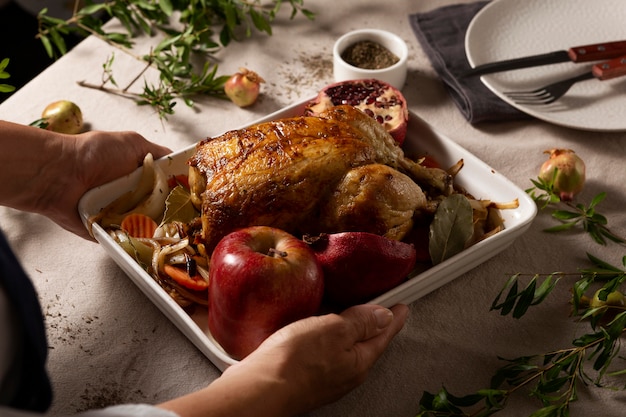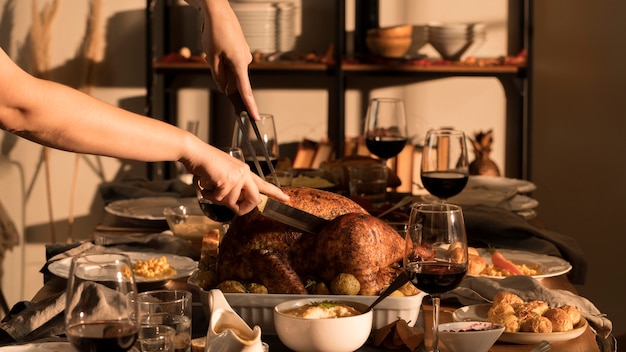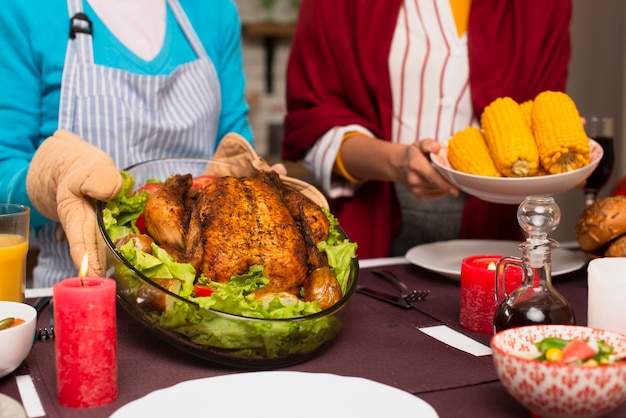Right, let's get down to business. The festive season is upon us, and that means one thing – turkey time! Now, I've been tackling this bird for years, and trust me, it's an art form. From the initial brining to the final basting, from the stuffing to the gravy, there's a lot to consider. But don't worry, I'm here to guide you through every step, sharing my own tried-and-true tips and tricks to help you create a truly delicious Christmas centrepiece.
(Part 1) Choosing Your Turkey
Picking the Perfect Bird

The first step is choosing the right turkey. Now, I always go for free-range – they tend to have a much richer flavour, in my opinion. Then you've got the size – a good rule of thumb is about 1lb (450g) per person, but if you're planning on having lots of leftovers (and who isn't!), go for a larger bird. You'll be glad you did!
Fresh or Frozen? A Question of Taste

The big question – fresh or frozen? Personally, I prefer fresh, it just seems juicier and more flavourful. But if you're buying it in advance, frozen is perfectly fine. Just make sure you give it plenty of time to defrost in the fridge – at least a day for every 5lb (2.3kg) of turkey.
Knowing Your Weight

Once your turkey is home, it's time to check the weight. This will help you decide how long to cook it. You can find the cooking time in a recipe, but remember to adjust it based on the weight of your bird.
Prepping the Turkey
Cleaning and Drying: A Simple Start
Okay, you've got your turkey, now it's time to get it ready for the oven. First, give it a good rinse inside and out with cold water. Then, pat it dry with kitchen paper. This will help the skin to crisp up nicely, giving you that golden-brown, irresistible look.
Removing the Giblets: A Gift of Flavor
Next, you need to remove the giblets – those little bags of organs that are usually found inside the turkey. Don't throw them away! They're actually a gift. You can use them to make a delicious gravy, adding an extra layer of richness and flavour. Just make sure you keep them separate from the rest of the turkey.
Brining: The Secret to juicy turkey
The Art of Brining
Now, let's talk about brining. This is a bit of a controversial topic, but I'm a firm believer in its benefits. Essentially, brining involves soaking the turkey in a salt solution, which helps to keep it moist and tender.
The Benefits of Brining
There are lots of advantages to brining. Firstly, it helps to keep the turkey moist, so it doesn't dry out during cooking. This is especially important for larger turkeys, as they can be prone to dryness. Secondly, it adds flavour to the meat, making it more succulent and delicious. Imagine juicy, flavorful turkey – that's what brining gives you.
Choosing Your Brining Method
There are two main methods of brining: dry and wet. Dry brining involves rubbing the turkey with a salt mixture, while wet brining involves soaking the turkey in a salt solution. I prefer wet brining, as it seems to work better for me, but it's really up to you!
A Simple Wet Brine Recipe
Here's a basic wet brining recipe that I use:
Ingredients:
- 1 gallon (4.5 litres) cold water
- 1 cup (240ml) kosher salt
- 1/2 cup (120ml) brown sugar
- 1/4 cup (60ml) black peppercorns
- 2 bay leaves
- 1 tablespoon (15ml) dried thyme
Instructions:
1. In a large stock pot, combine all the ingredients. Stir until the salt and sugar are dissolved. You want a nice, even solution.
2. Place the turkey in a large plastic bag or container that will fit the bird comfortably. You don't want it to be cramped.
3. Pour the brine solution over the turkey, making sure it's fully submerged. Everything should be covered!
4. Refrigerate for 12-24 hours, turning the turkey occasionally. This will help ensure even brining.
5. Remove the turkey from the brine and pat it dry with kitchen paper. You're almost ready to cook!
Stuffing: A Delicious Sidekick
The Stuffing Dilemma
Now, let's talk stuffing. This is one of the most debated parts of the turkey, with some people opting for a traditional sausage stuffing, while others prefer a lighter herb-based version. Whatever your preference, make sure you cook your stuffing separately. Never cook stuffing inside the turkey, as it can be dangerous.
My Favourite Sage and Onion Stuffing
Here's my favourite sage and onion stuffing recipe:
Ingredients:
- 1 large onion, chopped
- 2 tbsp olive oil
- 100g sage leaves, finely chopped
- 250g white bread, cubed
- 100g sausage meat
- 1 tbsp dried thyme
- 2 tbsp chopped parsley
- 1 chicken stock cube
- 250ml hot water
- Salt and black pepper, to taste
Instructions:
1. Heat the oil in a large pan over a medium heat. Add the onion and cook until softened, about 5 minutes.
2. Add the sage and cook for a further minute. Remove from the heat and set aside.
3. In a large bowl, combine the cubed bread, sausage meat, thyme, parsley, and salt and pepper. Mix well to combine all the flavors.
4. Add the cooked onion and sage mixture to the bread mixture.
5. In a separate jug, dissolve the chicken stock cube in the hot water. This will make a flavorful broth for your stuffing.
6. Gradually add the hot water to the bread mixture, stirring until the stuffing is moist. You want it to be moist, but not soggy.
7. Spoon the stuffing into a greased ovenproof dish and cook in a preheated oven at 180°C (350°F) for 30 minutes, or until golden brown and cooked through.
Cooking the Turkey: The Grand Finale
(Part 2)
The Roasting Process
Now it's time for the main event - cooking the turkey! I always roast my turkey in a preheated oven at 180°C (350°F). First, make sure you've got a roasting tin large enough to hold the turkey comfortably. Then, rub the skin with butter or olive oil. This will help it to crisp up nicely.
Stuffing the Bird: A Controversial Choice
If you're using stuffing, now's the time to stuff the turkey. I like to stuff the cavity loosely, so the stuffing can cook evenly. Be careful not to overfill it, as this can make the turkey difficult to cook.
Cooking Time: A Guide to Success
The cooking time will vary depending on the weight of your turkey. A good rule of thumb is to allow 20 minutes per pound (450g) of turkey, plus an extra 30 minutes for a larger bird.
The Importance of a meat thermometer
I always use a meat thermometer to make sure my turkey is cooked through. Insert the thermometer into the thickest part of the thigh, without touching the bone. The turkey is cooked when the internal temperature reaches 165°F (74°C).
Basting: The Secret to Moisture
While the turkey is cooking, it's important to baste it regularly. This will help to keep it moist and tender. Use the juices from the roasting tin to baste the turkey, or you can add some extra butter or oil for extra flavour.
Resting: Essential for Juiciness
Once the turkey is cooked, it's important to let it rest for at least 30 minutes before carving. This will allow the juices to redistribute throughout the meat, resulting in a juicier, more tender turkey.
Carving the Turkey: A Skill to Master
Carving Tips: A Step-by-Step Guide
carving a turkey can be a little daunting, but don't worry, it's not as hard as it looks. Start by removing the legs and thighs. Then, carve the breast into slices. Be careful not to overcook the meat, and try to keep the slices as even as possible.
Making Gravy: A Delicious Finishing Touch
A Delicious homemade gravy
No turkey feast is complete without a delicious gravy. You can make gravy from the turkey drippings, but I prefer to make my own from scratch. Here's my favourite recipe:
Ingredients:
- 2 tbsp butter
- 2 tbsp plain flour
- 1 cup (240ml) turkey stock
- 1/2 cup (120ml) red wine
- Salt and black pepper, to taste
Instructions:
1. Melt the butter in a saucepan over a medium heat.
2. Whisk in the flour and cook for 1 minute, stirring constantly. You want a smooth roux.
3. Gradually add the turkey stock, whisking continuously to prevent lumps.
4. Bring the gravy to a boil, then reduce the heat to low and simmer for 5 minutes, or until thickened.
5. Stir in the red wine and season to taste with salt and pepper. Adjust the seasoning to your preference.
6. Serve hot over the turkey and vegetables.
Serving the Turkey: A Feast for the Senses
A Variety of Sides
Now, for the sides. There are so many delicious options to choose from, but my favourites include:
- roast potatoes – crispy on the outside, fluffy on the inside – a classic for a reason!
- Roasted vegetables – add color and flavor, and you can use seasonal produce for a truly festive touch.
- Stuffing – a must-have! As mentioned before, make sure you cook it separately.
- Cranberry sauce – tart and sweet, it's a perfect complement to the turkey.
- Bread sauce – a traditional British favorite, rich and creamy.
Setting the Table: A Festive Touch
And lastly, don't forget to make your table look festive! I like to use a tablecloth and napkins in a festive colour, such as red or green. And of course, no turkey feast is complete without a centrepiece, such as a Christmas wreath or a vase of flowers.
(Part 3)
Leftover Turkey: A Culinary Treasure
Storing Leftovers: Safely and Effectively
Once you've enjoyed your delicious turkey feast, it's time to think about leftovers. Make sure you store them properly to prevent food poisoning. The best way to store leftovers is in the fridge, in an airtight container. They should be used within 3 days.
Leftover turkey recipes: Beyond the Sandwich
There are lots of delicious things you can do with leftover turkey. Here are a few of my favourites:
- turkey sandwiches – a classic! You can add various toppings like cranberry sauce, stuffing, and cheese for extra flavour.
- turkey soup – warm and comforting, it's perfect for a chilly day. Add vegetables, noodles, or rice for a complete meal.
- Turkey pies – a hearty and satisfying meal. Use leftover gravy and vegetables for a flavorful filling.
- turkey salad – a light and refreshing option. Combine chopped turkey with mayonnaise, celery, and your favorite herbs and spices.
Troubleshooting: Dealing with Common Challenges
Common turkey cooking Problems
Here are some common problems you might encounter when cooking turkey:
- Dry turkey – this can be frustrating, but luckily, there are solutions!
- Overcooked turkey – nobody wants rubbery turkey! Let's avoid that.
- Undercooked turkey – safety first! We want to make sure our turkey is fully cooked.
Troubleshooting Tips: Keeping Your Turkey Perfect
Here are some tips for troubleshooting common turkey problems:
Dry Turkey:
- Brine the turkey – this is a key step to prevent dryness, as mentioned earlier.
- Baste the turkey regularly – keep it moist with those delicious juices.
- Cover the turkey with foil for the first part of cooking – this helps trap moisture and keeps the turkey from drying out too quickly.
Overcooked Turkey:
- Reduce the oven temperature – a lower temperature can prevent overcooking.
- Cook the turkey for a shorter time – use a meat thermometer to ensure the turkey is cooked to the correct temperature.
Undercooked Turkey:
- Cook the turkey for a longer time – ensure it reaches the safe internal temperature of 165°F (74°C).
- Make sure the internal temperature reaches 165°F (74°C) – use a meat thermometer for accurate results.
FAQs: Frequently Asked Questions
What is the best way to defrost a frozen turkey?
The safest way to defrost a frozen turkey is in the refrigerator. Allow at least a day for every 5lb (2.3kg) of turkey to defrost. You can also defrost it in cold water, but make sure the turkey is completely submerged and change the water every 30 minutes.
How long should I cook a turkey for?
The cooking time for a turkey will vary depending on its weight. A good rule of thumb is to allow 20 minutes per pound (450g) of turkey, plus an extra 30 minutes for a larger bird. Use a meat thermometer to make sure the turkey is cooked through.
What temperature should the turkey be cooked to?
The internal temperature of the turkey should reach 165°F (74°C) to ensure it is cooked through. Use a meat thermometer to check the temperature in the thickest part of the thigh, without touching the bone.
How do I know if my turkey is cooked?
The turkey is cooked when the internal temperature reaches 165°F (74°C) in the thickest part of the thigh. You can also check the turkey is cooked by pressing on the breastbone. If it feels firm, the turkey is cooked.
What should I do with the giblets?
The giblets can be used to make a delicious gravy. Simply simmer them in water or stock until tender. Then, strain the liquid and use it as a base for your gravy. It will give it a rich, savory flavor.
Enjoy your perfectly cooked turkey!
Everyone is watching

How to Cook Frozen Lobster Tails Perfectly: A Step-by-Step Guide
RecipesLobster. Just the word conjures up images of lavish meals, special occasions, and a taste of luxury. But let's...

Pigs in a Blanket Cooking Time: How Long to Bake for Perfect Results
RecipesAh, pigs in a blanket. Just the name conjures up images of those delightful little parcels of crispy pastry en...

Pork Fillet Cooking Time: How Long to Cook It Perfectly
RecipesPork fillet, or tenderloin as it's sometimes called, is a real favourite in our house. It's so versatile, and...

The Ultimate Guide to Tender, Juicy Pulled Pork
RecipesRight, let's talk pulled pork. It's one of those dishes that just screams "comfort food," doesn't it? I mean...

The Ultimate Guide to Cooking Sweet Potatoes: From Roasting to Mashing
RecipesSweet potatoes. Just the name conjures up images of warm, comforting dishes, bursts of vibrant color, and a to...
